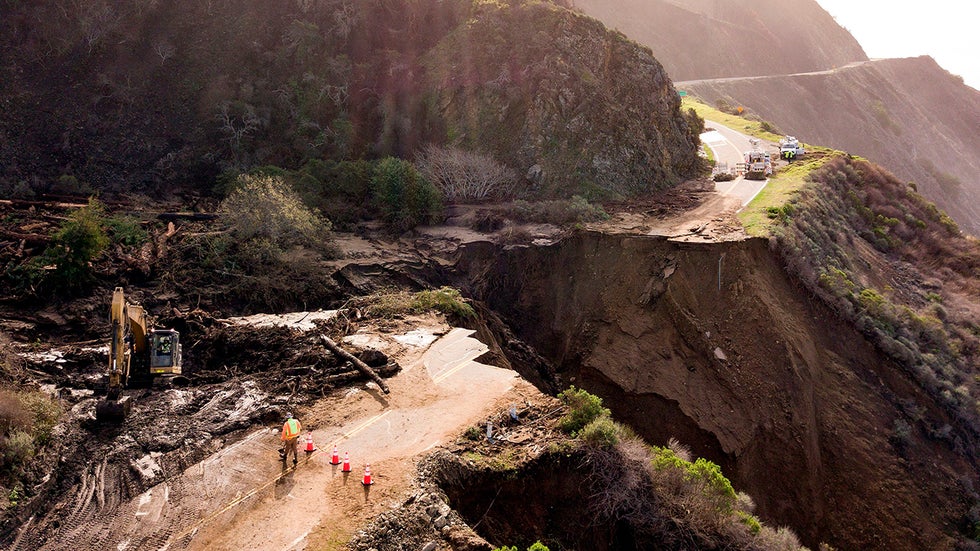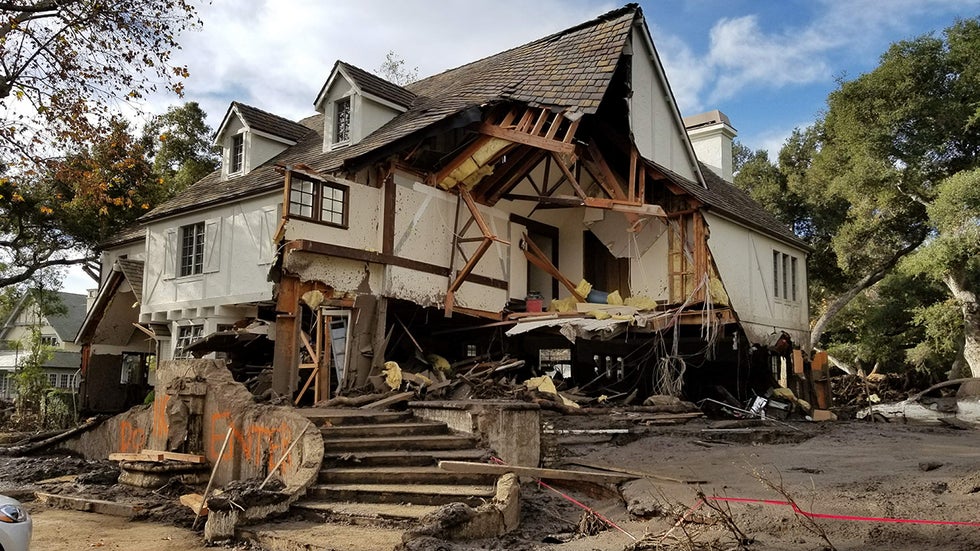Ron Brackett
 Construction crews work on a section of Highway 1, also known as the Pacific Coast Highway, that collapsed near Big Sur, California, on Jan. 31, 2021. Heavy rains caused debris flows of trees, boulders and mud that washed out a 150-foot section of the road after the mountainside was left vulnerable by a wildfire several months earlier.
Construction crews work on a section of Highway 1, also known as the Pacific Coast Highway, that collapsed near Big Sur, California, on Jan. 31, 2021. Heavy rains caused debris flows of trees, boulders and mud that washed out a 150-foot section of the road after the mountainside was left vulnerable by a wildfire several months earlier.Post-wildfire landslides are now likely to happen every year in Southern California and the region can expect major landslides every 10 to 13 years, according to a new study.
With climate change making rainfall more intense, major landslides — capable of damaging 40 or more structures — could occur even more frequently, said the study published in Earth’s Future, the journal of the American Geophysical Union.
"This is our attempt to get people thinking about where these hazards are going to be before there’s even a fire," Jason Kean, a U.S. Geological Survey hydrologist and lead author of the study, said in a news release. "By proactively thinking about hazards, you can start to develop more detailed response plans for their inevitability."
Landslides happen after wildfires strip vegetation from hillsides and there are no longer any plant roots to stabilize the soil. When it rains, the water liquefies the soil, causing mud, rocks and debris to rush down the hills.
(MORE: Eerie Photos Show Frozen Homes and Buildings in a Russian Ghost Town)
Using historical data on fire frequency, fire severity and rainfall intensity, combined with computer models, the researchers mapped areas where post-wildfire landslides are likely to occur in Southern California, somewhat similar to how the state currently maps earthquake hazards.
The study said the maps will give emergency managers warnings about areas where landslides could happen. Currently, these emergency managers often have little time between a fire and the first rainstorm to implement response and evacuation plans, the study said.
As an example, the study described how the Thomas Fire, which began in December 2017 and grew to be the largest fire in California history at the time, was still burning when a rainstorm unleashed debris flows on Jan. 9, 2018, above Montecito.
The debris flows killed 23 people, destroyed 246 structures and damaged another 167, according to the County of Santa Barbara.
 A home near Montecito, California, was damaged by a major landslide in January 2018 that happened after the 2017 Thomas Fire.
A home near Montecito, California, was damaged by a major landslide in January 2018 that happened after the 2017 Thomas Fire.California's wildfire season is getting longer, and recent research has shown the rainy season is getting shorter and more intense.
Cal Fire, the state's forestry and fire protection agency, said in its 2021 Fire Season Outlook, "While wildfires are a natural part of California’s landscape, the fire season in California and across the West is starting earlier and ending later each year. Climate change is considered a key driver of this trend ... The length of fire season is estimated to have increased by 75 days across the Sierras and seems to correspond with an increase in the extent of forest fires across the state."
SPONSORED: Sale on Patagonia at Paragon Sports
The rainy season, which historically began in November, is starting 27 days later than it did in the 1960s, according to a study released in early February. The rain that does fall is concentrated during the months of January and February.
"We're going to have a longer season to burn and then when it does rain, it's going to come down harder. And that's a bad recipe for these post-fire debris flows," said Kean, the USGS hydrologist. "The reason you can expect one just about every year is because it doesn't take very much rain to cause one. The rainstorms that can trigger debris flows – they're kind of garden-variety storms."
Kean said he hopes emergency managers can use the study's results to set up evacuation zones for landslides before they happen.
"We'll still always do hazard assessments after fires because we really want to know the details of the actual fire, but these wildfire scenarios and storm scenarios are useful because we can start looking ahead and have the luxury of time to make a better plan," he said.
The Weather Company’s primary journalistic mission is to report on breaking weather news, the environment and the importance of science to our lives. This story does not necessarily represent the position of our parent company, IBM.
The Weather Company’s primary journalistic mission is to report on breaking weather news, the environment and the importance of science to our lives. This story does not necessarily represent the position of our parent company, IBM.

No comments:
Post a Comment